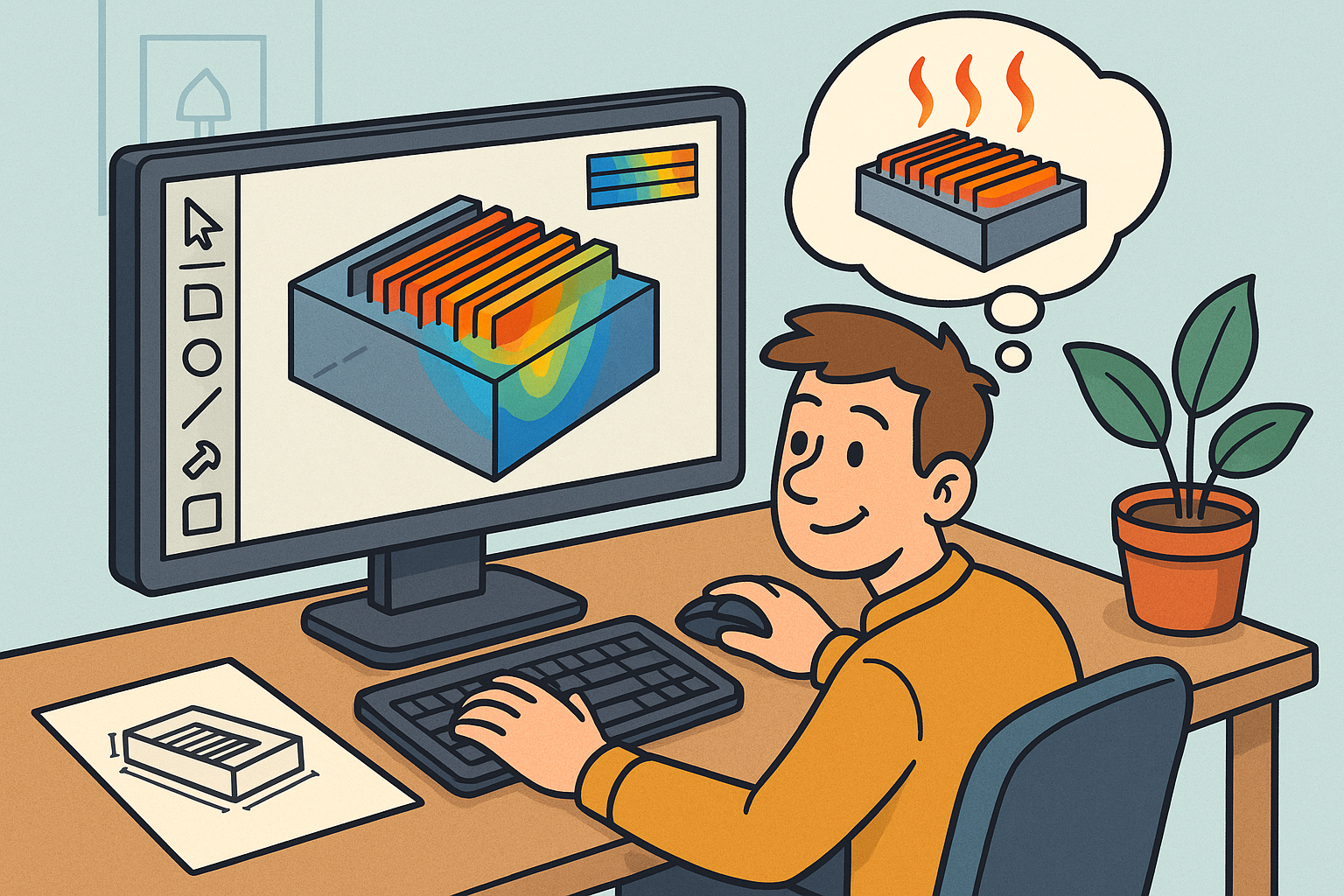Your Cart is Empty
Customer Testimonials
-
"Great customer service. The folks at Novedge were super helpful in navigating a somewhat complicated order including software upgrades and serial numbers in various stages of inactivity. They were friendly and helpful throughout the process.."
Ruben Ruckmark
"Quick & very helpful. We have been using Novedge for years and are very happy with their quick service when we need to make a purchase and excellent support resolving any issues."
Will Woodson
"Scott is the best. He reminds me about subscriptions dates, guides me in the correct direction for updates. He always responds promptly to me. He is literally the reason I continue to work with Novedge and will do so in the future."
Edward Mchugh
"Calvin Lok is “the man”. After my purchase of Sketchup 2021, he called me and provided step-by-step instructions to ease me through difficulties I was having with the setup of my new software."
Mike Borzage
Integrating Thermal Analysis in Design Software for Optimal Product Performance
July 27, 2025 9 min read


Introduction and the Rationale for Thermal Analysis Integration
Thermal analysis is a comprehensive simulation technique used to evaluate and predict the thermal behavior of components and systems under various environmental conditions. This integrated approach not only determines the heat distribution and temperature fluctuations within a product but also forecasts the consequent material responses and potential failure modes. In the realm of product design, thermal analysis has become a **critical tool** that ensures design safety, improves performance, and contributes significantly to cost-efficiencies over the lifecycle of a product. Its significance lies in providing insights into how excess heat can affect components, how materials might deteriorate over time due to thermal loads, and how design modifications can mitigate these adverse effects. Without such analysis, designers risk unforeseen failures that could lead to expensive post-production corrections or, worse, product recalls.
Definition and Significance of Thermal Analysis in Product Design
Thermal analysis is essentially a simulation-based method that captures the intricate interplay between heat generation, heat transfer, and environmental conditions affecting a product's performance. In many advanced industries, a comprehensive understanding of thermal principles is critical for ensuring that products operate reliably under extreme conditions. The process involves a series of computations and models that predict how a design will behave when subjected to heat loads, fluctuating ambient temperatures, and even dynamic thermal environments. Thermal analysis offers tangible benefits, ranging from the optimization of materials used to the overall structure's design to ensure maximum durability and efficiency.Addressing Current Challenges in Ensuring Thermal Reliability
Current challenges in maintaining thermal reliability include the complexity of modern designs, the growing demand for miniaturization, and the increasing thermal loads in various applications such as electronics and aerospace. Engineers today face the intricate task of accurately predicting heat transfer phenomena in multi-physics environments. Among the most pressing issues are the accurate modeling of material behavior under thermal stress, the reliability of interface thermal resistance models, and ensuring seamless communication between simulation results and design iterations. Frequently, designers emphasize the importance of integrating thermal analysis tools early in the design phase to identify potential thermal risks before significant investments in tooling or production begin. The incorporation of this step results in a more robust design process, which enhances product safety, performance, and cost savings by preventing late-stage design alterations.Integrating Thermal Analysis Tools for Enhanced Safety and Performance
Integrating thermal analysis tools into the early stages of the product design process changes the way engineers approach potential issues. By embedding simulation techniques into existing workflows, teams can capture thermal challenges at an earlier stage, effectively shortening development times, reducing prototyping cycles, and optimizing material selection. This integration not only enhances the reliability of a product but also contributes significantly to cost-efficiency, as early detection of thermal issues curtails the need for extensive rework. Key benefits include the ease of simulating various environmental scenarios, improved understanding of stress distribution under thermal loads, and better alignment of product performance with operational expectations. Moreover, when conducting thermal simulations, engineers can evaluate multiple design iterations quickly using advanced computational models, leading to rapid product refinements that ensure high-quality performance standards. The harmonious blend of solution safety, operational efficiency, and economic prudence underscores the transformative potential of integrating thermal analysis in modern product design.Overview of Thermal Analysis Tools in the Design Workflow
The design workflow for advanced product development now encompasses a range of sophisticated thermal analysis tools that simulate and visualize heat distribution within design models. These tools include simulation modules capable of heat transfer modeling, material behavior analysis under thermal loads, and even predictive forecasting to anticipate potential design failures due to thermal stress. Each of these functionalities plays a vital role in ensuring that the final product is resilient, safe, and performs as intended under various operating conditions. In addition, modern implementations of these tools allow for seamless integration with traditional CAD/CAM software, ensuring minimal disruption in the design process while offering comprehensive analytical insights. Designers now appreciate the importance of a concurrent design approach where thermal simulation is not a post-design check but an integral part of the iterative process.
Key Functionalities of Advanced Thermal Analysis Software
Thermal analysis software today includes the following robust features:- Heat Transfer Modeling: Accurately simulates conduction, convection, and radiation, providing precise temperature distributions across the design.
- Material Behavior Analysis: Predicts how different materials respond to thermal stress, including phase changes and thermal expansion effects.
- Simulation and Visualization: Offers real-time visualization of temperature gradients and hot spots, helping engineers make informed decisions regarding design changes.
- Predictive Modeling: Uses historical data and advanced algorithms to forecast potential failure modes, enhancing reliability.
Interoperability with CAD/CAM and Other Design Platforms
One of the most significant advancements in recent years has been the enhanced interoperability between thermal analysis tools and various design platforms such as CAD/CAM systems. This integration ensures that engineers can easily incorporate thermal modeling data into their ongoing design workflows. By allowing seamless data exchange, CAD/CAM systems and thermal simulation software collaborate to create an iterative loop in which design revisions are instantly validated against thermal performance metrics. The benefits of this synergy include:- Streamlined workflows: Improved data consistency and reduction of manual data re-entry errors.
- Enhanced collaboration: Designers and thermal analysts can work concurrently, ensuring that design and analysis processes are tightly coupled.
- Accelerated prototyping: Faster turnaround times and early detection of potential thermal issues lead to reduced time-to-market.
Emerging Trends and Recent Innovations in Thermal Analysis Capabilities
The thermal analysis landscape is continuously evolving with innovations that enhance both the accuracy and the usability of simulation tools. Designers and engineers are increasingly relying on cloud-based simulation environments, which provide high computational power and enable collaborative work across geographically dispersed teams. Additionally, the integration of artificial intelligence (AI) techniques is revolutionizing the predictive capabilities of these systems. Key emerging trends include:- AI-enhanced simulation: Machine learning algorithms are being used to refine simulation predictions and optimize thermal response models.
- High-performance computing: Cloud computing and parallel processing techniques streamline the handling of enormous simulation datasets.
- Real-time analysis: Advances in sensor technology and data acquisition networks are enabling near real-time thermal feedback, allowing for dynamic simulation updates.
Impact on Product Design Workflows and Integration Strategies
Integrating thermal analysis into product design workflows profoundly reshapes the entire engineering process. It provides creators with a proactive view of potential thermal problems, which ultimately leads to a smoother design realization process and accelerated prototyping cycles. By incorporating these analytical tools early in the design process, teams can detect and resolve areas prone to thermal stress before they become critical issues. This proactive approach reduces costly reworks and design iterations while ensuring that the final product achieves optimal performance. Many design practices now leverage these advanced techniques to predict not only normal operating conditions but also transient thermal events under extreme conditions. The effective coupling of simulation data with design adjustments therefore accelerates the path from concept to production without compromising on quality.
Shortened Development Time Through Early-Stage Detection
A significant impact of thermal analysis integration is the dramatic shortening of the product development cycle. By identifying potential thermal issues during the initial design phases, engineers are able to address inefficiencies and material weaknesses before forming a physical prototype. The early-stage detection of hot spots, thermal fatigue, and potential material degradation allows teams to:- Implement design changes before final evaluations.
- Optimize the use of advanced materials with superior thermal conduction and insulation properties.
- Reduce the need for expensive and time-consuming subsequent re-tests and physical prototypes.
Enhanced Material Selection and Design Optimization
The integration of thermal analysis greatly influences how materials are selected and applied within a design framework. Engineers are presented with detailed insights into not only the thermal properties of individual materials but also how these materials interact under varying operating conditions. This in-depth understanding allows them to fine-tune design features and help ensure that the chosen materials will not compromise structural integrity or reliability over time. Key benefits include:- Improved performance: Optimization of materials leads to better thermal management and overall product efficiency.
- Cost-effectiveness: Early material selection minimizes costly redesigns and enhances lifecycle value.
- Design innovation: Encourages creative approaches in using composite and advanced materials that exhibit superior thermal properties.
Overcoming Integration Challenges and Strategies for Success
Despite the transformative benefits, incorporating thermal analysis into product design workflows is not without its challenges. Many organizations initially encounter hurdles related to data interoperability, the steep learning curve associated with sophisticated simulation software, and the need for cross-disciplinary collaboration between design engineers and thermal specialists. Overcoming these challenges requires a carefully planned strategy that includes:- Robust training programs: Ensuring that designers and engineers are well-versed in the capabilities and limitations of thermal analysis tools.
- System integration frameworks: Establishing protocols for data exchange between CAD/CAM systems and simulation software to maintain consistency and fidelity.
- Collaborative platforms: Using integrated digital platforms to facilitate real-time communication and decision-making across teams.
Conclusion
In summary, the integration of thermal analysis into product design workflows provides a robust framework for addressing complex thermal challenges in modern engineering. The benefits of early detection of thermal issues, improved material optimization, and shortening of the overall development cycle underscore the value of incorporating these advanced simulation tools. Through sophisticated modules for heat transfer modeling, material behavior analysis, and predictive simulations, thermal analysis has emerged as a transformative force in industries ranging from electronics to automotive, aerospace, and beyond.
Future Trajectory of Thermal Analysis in Design Software Innovation
As product designs become increasingly complex and performance standards continue to rise, the role of thermal analysis is expected to grow even more prominently in the design process. Future innovations, including deeper integration with artificial intelligence, enhanced cloud-based simulation environments, and real-time data analytics, will only amplify the ability of designers to predict and prevent thermal challenges. This ongoing evolution promises to deliver even more accurate, efficient, and cost-effective design solutions. Moreover, organizations that embrace these technological advancements will be better positioned to meet market demands, ensuring that their products remain competitive while also fulfilling heightened safety and performance criteria. The journey toward fully integrated, predictive design workflows represents a pivotal moment in engineering, emphasizing the strategic importance of combining comprehensive thermal analysis with cutting-edge design methodologies.Recommendations for Organizations Adopting Advanced Thermal Analysis
For organizations looking to elevate product performance and reliability, the adoption of advanced thermal analysis tools should be considered a strategic imperative. Key recommendations include:- Invest in training: Empower engineers and designers with the knowledge and skills needed to effectively leverage these tools.
- Integrate systems: Utilize interoperability standards that allow seamless communication between CAD/CAM platforms and thermal simulation software.
- Foster collaborative cultures: Encourage cross-disciplinary teams to work closely, ensuring that thermal analysis is fully embedded throughout the design process.
Also in Design News

Revolutionizing Telecommunications: The Rise of Advanced Design Software
August 31, 2025 16 min read
Read More
Cinema 4D Tip: Optimizing 2D Matte Integration with Projection Man in Cinema 4D
August 31, 2025 3 min read
Read MoreSubscribe
Sign up to get the latest on sales, new releases and more …



